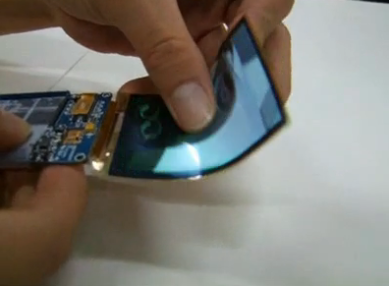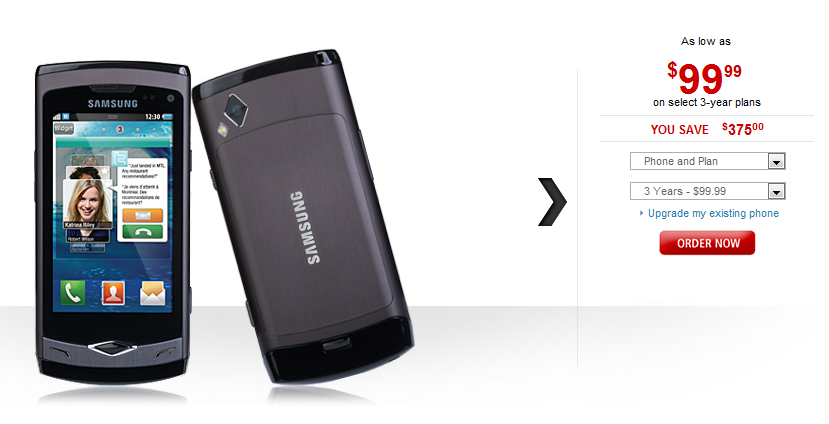Samsung Bada

Samsung Developing Flexible, “Unbreakable” AMOLED Displays
Jul 20th
 It looks like Samsung is taking to task the problem of broken screens in mobile devices with the development of flexible AMOLED screens. They have given one of these screens a beating (literally) and it seems to hold up quite well, especially when compared to a “normal” screen. The biggest problem with the idea of a flexible display is that unless the digitizer—the component which overlays the screen and actually registers touch input—is flexible, it will still be easily broken if the device takes a hard fall. The worst thing is, the digitizer is what makes Samsung’s SuperAMOLED displays so super. Who knows if the same results could even be achieved if the digitizer were flexible. We’ve got the screen-smashing footage queued up for you after the break.
It looks like Samsung is taking to task the problem of broken screens in mobile devices with the development of flexible AMOLED screens. They have given one of these screens a beating (literally) and it seems to hold up quite well, especially when compared to a “normal” screen. The biggest problem with the idea of a flexible display is that unless the digitizer—the component which overlays the screen and actually registers touch input—is flexible, it will still be easily broken if the device takes a hard fall. The worst thing is, the digitizer is what makes Samsung’s SuperAMOLED displays so super. Who knows if the same results could even be achieved if the digitizer were flexible. We’ve got the screen-smashing footage queued up for you after the break.
[Via OLED-Display.net]
Price Drops Coming For Rogers Android Handsets
Jul 12th
Rogers is usually pretty competitively priced with their phones. They can have such large subsidies because in Canada, with three-year contracts, they are guaranteed a certain amount of revenue per customer. And Rogers’ monthly charges, especially for a smartphone, are not cheap.
So a few handsets are coming down in price, and while none are earth-shattering, they bring the devices down to a certain level where, when the iPhone 4 arrives, they will still be attractively and competitively priced.
![]() Firstly, the Sony Ericsson Xperia X10 is coming down in price from $149.99 to $99.99. This is a very nice Android handset that has just received a nice little upgrade to improve performance and battery life, though in reality if it’s not Android 2.1 no one really wants it.
Firstly, the Sony Ericsson Xperia X10 is coming down in price from $149.99 to $99.99. This is a very nice Android handset that has just received a nice little upgrade to improve performance and battery life, though in reality if it’s not Android 2.1 no one really wants it.
The Motorola QUENCH and Acer Liquid e are both coming down from $49.99 to $29.99. These are capable phones, but I would take the Acer over the QUENCH, since the specs are much better and the screen is gorgeous, and it currently runs Android 2.1 while the QUENCH runs Android 1.5 on top of Motorola’s MOTOBLUR skin, which is great for quick messaging and terrible for everything else.
The long-in-the-tooth Samsung Galaxy Spica is coming down from $29.99 to $9.99. This is also a nice phone, great specs and is very hardy, but is still running Android 1.5! So the faster this phone gets off the market, the better for Android fragmentation.
![]() And lastly, the brand-newly launched Samsung Wave is already receiving a price cut, from $99.99 to $79.99. This phone runs on Samsung’s own bada OS, and has not really been proven to give any advantage over existing platforms. Read my editorial on why the Wave will likely flop in Canada (and elsewhere).
And lastly, the brand-newly launched Samsung Wave is already receiving a price cut, from $99.99 to $79.99. This phone runs on Samsung’s own bada OS, and has not really been proven to give any advantage over existing platforms. Read my editorial on why the Wave will likely flop in Canada (and elsewhere).
Remember, all these prices are for new customers who sign a three-year contract. So take that into account when buying a phone you are likely going to spend a lot of time with over the next three years.
Does Bada have a place in the Canadian market place?
Jul 8th

Today, Rogers Wireless announced the immediate availability of the Samsung Wave, the cousin to the Galaxy S series running its own Bada operating system instead of Android. While not a lot of good things have been said about the Bada platform, especially when compared to the robust existing offerings from Apple, Google and RIM, its mere existence brings home the point that phone manufacturers, from Samsung to HTC, are seriously considering branching into independent software platforms to embed onto their hardware.
But where is the value here for Samsung? Developers will likely balk at the idea of developing for yet another mobile platform, especially after realizing that it is a lot harder to make money off their apps than they first considered. Yes, especially in the App Store, there are tons of success stories, but for every one that succeeds there are many that don’t.
Perhaps then it is in the value of a closed ecosystem for the company. Designing both the hardware and software allows them complete control over how the phone interacts with the OS. They have seem Apple’s success with this; the opportunities for in-app advertising as well as product tie-ins are quite attractive. And if the Bada platform can be expanded to work on tablets, microwaves, printers… the opportunities are seemingly endless.
But there are also tons of ways to fail here. Without robust first-party capabilities, Bada doesn’t stand a chance of luring people away from the Apple monster. Without extensive HTML5 support or a deep app store, why pay $99 for a Samsung Wave when the 8GB iPhone 3GS is the same price with the same carrier.
The hardware on the Wave seems good. 3″ Super AMOLED 800×480 screen, 1GHZ Hummingbird processor, 5MP camera, WiFi, GPS. But good specs are no longer good enough to take people away from what they know.
And Rogers, pricing the device at $99, is positioning it in the smartphone category. Not smart. I will reserve final judgment, however, until I have used the device, and you can expect a review here soon.
For more info, check out Rogers’ site: Samsung Wave






Interact With Us